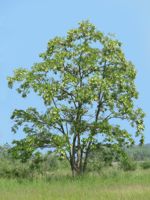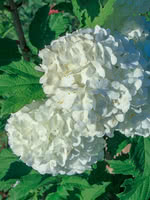Mon-Fri 9am - 5pm Mountain time
Black Locust vs Snowball Viburnum
Robinia pseudoacacia
Viburnum opulus roseum
Black Locust is an attractive tree. Its distinctive leaves are made of about a dozen bright green leaflets. It also notable for its fragrant white flowers, which smell of citrus.
Black Locust can grow in many situations, but prefers dry areas with lots of sun. It is robust and is an excellent choice for establishing shade in dry, open areas.
Important note: Much of the Black Locust is toxic to humans and livestock, including seeds, bark, and leaves.
Snowball Viburnum is a popular ornamental shrub with prolific flowering. This plant is prized for its round clusters of white flowers that resemble snowballs, delighting children and adults. In fall, its leaves turn vibrant shades of red.
Snowball Viburnum is sought after as a single accent shrub, but can also make a dense hedge or privacy screen.

